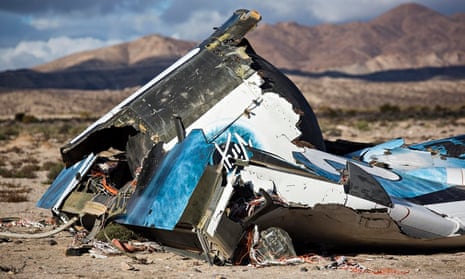The pilot who survived last month’s Virgin Galactic disaster has told investigators how he was thrown from the disintegrating SpaceShipTwo still strapped in to his seat, nine miles above the ground and travelling at more than 600mph, according to a report released on Wednesday by the US National Transportation Safety Board (NTSB).
Peter Siebold, 43, was unaware that the feathering system that controls descent had been unlocked early by co-pilot Michael Alsbury, who was killed in the crash in the Mojave desert in California on 31 October, the NTSB said.
At the time of the disaster the craft had its rocket engine engaged and had just accelerated past the speed of sound. It was about nine miles above the surface of the earth – nearly twice as high as the peak of Mount Everest. At this altitude the atmosphere is so thin as to be unbreathable, and the temperature around -50C.
Siebold, who was discharged from hospital on Monday, told investigators that he unbuckled himself from his seat at some point during his fall, after which his parachute deployed automatically.
SpaceShipTwo’s destruction came just 27 seconds after it was released from its carrier aircraft.
When the craft hit Mach 1.02, 10 seconds after its engines were ignited, the ship’s “feather” system – which is designed to stabilise the craft during re-entry – was unlocked, and almost immediately began to deploy. It was at this moment that the craft began to tear itself apart.
Parts of the destroyed ship were found spread across more than 35 miles of the Mojave desert.
Speaking to investigators from the NTSB on 7 November, Siebold said he was unaware that his co-pilot had prematurely unlocked the “feather” system, which is supposed to be unlocked only once the ship reaches Mach 1.4.
The NTSB said that on-board video showed the co-pilot, Alsbury, unlocking the mechanism just after reached Mach 1. They said that a second lever to deploy the mechanism was not pulled, but that that the force of the air at that speed and altitude might have caused it to deploy.
The NTSB’s acting chairman Christopher Hart suggested this was what caused the ship to tear itself apart, though the investigation could take a year or more to complete.

Comments (…)
Sign in or create your Guardian account to join the discussion